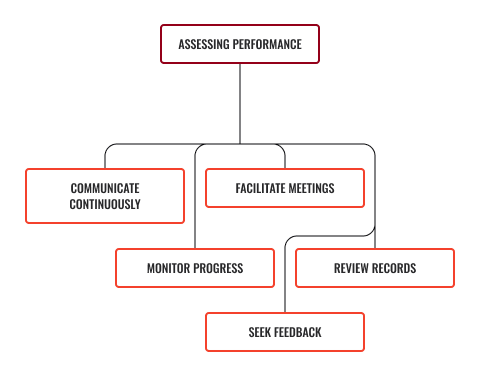The first step towards using technology efficiently for workplace collaboration, is to evaluate what is currently being used. This would enable you to understand the context within which you will operate. This first step is hugely important to ensure the most effective use of current technologies prior to adapting current use or introducing new technologies. This would enable you to understand the context within which you will operate.
It is important to be thorough and careful when doing this first step, as it involves a lot of research. This step is further divided into three sub-steps. First, you begin by identifying current collaborative ways of working. Once you have accomplished this, you will move on to assess the performance of current collaborative ways of working against organisational strategies and objectives. Finally, you are to collate the information collected through review and provide it to relevant personnel as required. Let us take a closer look at these, starting with, identifying current collaborative technologies used in the workplace.
Collaborating with relevant personnel
Collaboration in the workplace is working with fellow employees towards achieving organisational goals and objectives. It is an indispensable part of any functioning organisation, an organisation should not be composed of individual members working by themselves, rather, individuals coming and working together to meet set objectives and goals. Digital technologies are essential tools that will enable you to better collaborate within the organisation.
Throughout this entire process, you must remember that your role is to engage in collaboration with the relevant personnel. This may include your direct supervisor, manager, department head, any other superior, the Information Technology (IT) Officer in your organisation, and other staff who would be directly involved in the process of selecting, monitoring and maintaining digital systems and communication channels within the organisation (such as IT staff, Human Resources Officer and/or staff).

What is workplace collaboration?
The collaborative ways of working refer to processes that involve two or more people working together through idea sharing, brainstorming, or thinking to complete a task or achieve a goal. To learn more about some of the most common collaborative workplace processes and what they offer, click on the links below.
This refers to the way employees would send regular progress reports regarding the status of their projects. The value of communicating updates is that it ensures that you are staying on track, following set timeframes, and meeting the objectives that have been established. Moreover, this process enables employees to report on any issues they may encounter along the way. This helps you to recognise and potentially avoid or readily resolve any problems or delays.
When coordinating team schedules, team members would set timeframes, deadlines, as well as meetings and other common touchpoints to keep each other in check. However, the work would not end there. Members would keep their schedules in sync by means of monitoring their progress, including any possible delays or issues they may encounter along the way. All this information will be shared within the team. In keeping each other updated, members can keep each other in check, ensuring that everyone is on the right track. Should there be members who are not on track, coordinating schedules effectively enables the team to make the necessary adjustments to help the members falling behind.
Meetings are a fundamental method of collaborating. Whether it be in person or virtual, setting regular meetings with the relevant personnel enables you to effectively keep everyone in check. Meetings serve as an efficient way to brainstorm, jointly make decisions, discuss important matters, and raise concerns. They help formalise your efforts to collaborate and serve as a reliable means to engage in other collaborative processes.
Document reviews are collaborative in nature. Seeking or aiding the review of a document require collaboration with fellow employees. Engaging in such a review is an essential collaborative process, as it enables others to share their insights on given outputs; these insights could further improve the work that has been done. Moreover, document reviews ensure an output’s alignment with overarching organisational goals and objectives.
Much like the document review, document approval is collaborative in nature. Seeking approval is essentially collaborating with relevant personnel – usually those of higher positions – to ensure that the document that you have put forth meets the standards set by the organisation. Should your output satisfy what is required, you would gain the approval that you seek. Otherwise, the relevant personnel are likely to give you points for improvement so you can revise the document accordingly.
Reporting is a necessary collaborative process in any task. It is important to remember that the work you put in your projects and initiatives does not end with implementation – you must evaluate your results against the set organisational objectives and goals and report these. This process is collaborative in nature, as it enables the necessary personnel to get involved in your project. In sharing the results of your findings, you can fully realise the value of the work you put in and contextualise it in the bigger picture – seeing how it may have positively or negatively impacted the organisation. The personnel you report to would provide their insights on your report, giving points for improvement as necessary so you can further improve upon your project in the future.
Digital technologies and their advantages
Digital technology, in the broadest term, refers to any equipment that uses electronic signals in the form of numeric code such as calculators, personal computers, and smartphones. Notably, the typical workplace increasingly makes use of digital technology and the internet. It is natural that, to operate in today’s business environment competitively, your organisation should maximise the use of digital technology.
There are many advantages to using digital technology within the workplace, such as:
Resource use
Digital technology’s biggest advantage is the reduced use of resources. Traditional recordkeeping involved the use of paper, filing cabinets and large storage, but today’s modern workplace has documents and records that are digital or being transformed to digital, saving physical storage space with hard drive space.
Mobility
By being smaller and more portable, digital applications are also more mobile. Given this, they are more accessible than earlier technology like paper files. For instance, cloud-based data storage systems have efficiently addressed the challenges of traditional data storage. Having a centralised cloud-based data storage system eliminates the need for users to store data on their own devices. Security is also centralised and ensures that company information and data are safe from malware and hackers.
Adaptability
Using digital technology has the added advantage of being able to cater to the needs of the user, needing only choose the application that has the functions and features that suit their needs. Businesses also have this option and sometimes can even request some degree of customisation in the applications they use through pricing packages and similar set-ups.

Digital applications and collaboration
A digital application refers to the software or a program used by computers, such as desktop computers, mobile phones, laptops. These applications perform various functions such as creating text documents, performing calculations, and keeping records.
In the workplace, digital applications either supplement or replace traditional processes and equipment. Such uses vary from file storage, security and more importantly, communication. They also assist in various areas of collaboration such as goal setting, active listening, problem-solving and time management.
One of the most useful improvements brought about by digital applications, is improved communication among the members of the workplace, from individual employees to teams, departments, and branches. Integrating digital technology with the connectivity of the internet, opens many possibilities for making workplace processes more effective and efficient. Previously, employees exerted much effort to physically attend meetings, which is both exhausting and time-consuming; nowadays, digital technologies like email and instant messaging allow for correspondence between any number of people over the internet.
Click on each of the following digital applications to read more about their collaborative tools.
Asana is a web and mobile application which serves as a work management platform, enabling you to efficiently track projects and coordinate team efforts. It has many useful features that enable you to:
- streamline tasks
- assign tasks
- create to-do lists
- set reminders and deadlines
- see a structured overview of what must be done in a project.
Moreover, Asana enables easy organisation of projects and provides a user-friendly interface that can be easily understood by almost anyone.
G Suite refers to a set of digital tools developed by Google that allows you to manage work and collaborate on various kinds of tasks. The main advantage of these tools is their easy access through any device. G Suite provides four types of tools, namely those to:
- Connect: These platforms enable you to communicate and coordinate with your colleagues through email (Gmail), shared calendars, chats, and video calls (Hangouts)
- Create: These platforms allow you to collaboratively work on projects which include documents (Google Docs), spreadsheets (Google Sheets), forms (Google Forms), presentations (Google Slides) and websites (Google Sites)
- Access: These platforms provide easy access to files along with safe and easy storage of your files
- Control: These platforms allow you to oversee all operations within the G Suite system by means of monitoring, analysing, and keeping your data secure.
Office 365 is Microsoft Office’s cloud-based office suite that enables you to work collaboratively in projects done through Microsoft platforms. Office 365, like G Suite, has a wide range of software. Its main advantage is the advanced level of functionality that it provides for its users.
Tools included in Office 365 are:
- Outlook: This refers to the email service, calendar, task, and contact manager platforms of Office 365
- Office applications: This includes the platforms for collaboratively working on your projects such as documents (Word), spreadsheets (Excel) and presentations (PowerPoint)
- SharePoint: This platform is used for storing and accessing files as well as managing and developing networks and applications
- Teams: This refers to the communication and collaboration platform of Office 365 that enables you to send instant chat messages, hold video meetings, store, and collaborate on files, as well as make use of the abovementioned platforms.
Skype is a video application and web conferencing platform that enables you to hold video calls and meetings. It is a tool that is popular among both individuals and businesses and has a plethora of features to enhance your calls. These include:
- Instant messaging: this allows you to send chat messages while you are in-call
- Document-sharing: this feature allows you to share any documents relevant to your meeting
- Screen-sharing: this feature is useful when you have a presentation to share with participants
- Whiteboard, polls, questions, and answer sessions: these are added tools you can use to aid your sessions, especially when you need to brainstorm and/or make decisions.
WeTransfer is a file-sharing platform that allows you to easily transfer files from one device to another in just a few steps. The main advantage of the platform is its ease of use and its capacity for sharing large files
Like Skype, Zoom is a web conferencing platform that enables you to have remote video meetings with up to a hundred participants. This platform promotes and maintains open communication across different team members regardless of their location. Zoom also offers additional tools that would improve the quality of your meeting. These include:
- Chat box: this allows you to send instant messages while you are in a video call
- On-screen whiteboard: this feature is useful when you are engaging in brainstorming sessions during your web conferences
- Screen-sharing: this feature is useful when you have a presentation to show to your video participants
- Screen-recording: this enables you to save and document your meetings.
Andrew has identified the need for new digital technologies, however, is unsure if and how the above platforms are currently being utilised. To gain a thorough understanding, Andrew sends out a survey to collate feedback from his peers.

In any workplace environment, communication and collaboration are considered the lifeblood of operations. All collaboration requires communication; therefore, it is important to ensure that the ways in which you work, enable you to communicate effectively. More importantly, your communications should all be relevant to the overall strategies and objectives of the organisation, let us investigate each of these terms.
Requirements of the organisation
To effectively assess the performance of the current ways of working you have in place, you must have a key understanding of organisational requirements. Every organisation must have these requirements. Essentially, they are the features that serve as the framework for all your efforts and initiatives within the organisation. These include:
Organisational goals
Organisational goals refer to the long-term aims and purpose of your organisation. These embody and represent what your organisation would like to achieve in the long run. Your goals respond to the following strategy-based question, ‘What are the overall aspirations of your organisation?’
To illustrate, a sample goal in line with the strategy above would be “to establish the organisation as one that is relevant and innovative”.
Organisational strategies
Organisational strategies refer to the definitive set of actions your business would make to achieve the goals that you have set. Essentially, your strategies respond to the question, ‘How will you ensure that your organisation will achieve its goals?’ Your strategies are the action steps in your organisational framework, for example, “become a digitally competitive organisation that uses up-to-date technologies”.
Organisational objectives
Organisational objectives are essentially the short-term aims of your organisation. These are in line with your goals and are the more easily achievable targets you would like to meet. By their very nature, objectives enable you to realise your goals. They are the more small-scale, digestible and achievable forms of your goals that must always be formulated to be SMART. This means that your objectives must be specific, measurable, achievable, realistic, and time-based. An example of an organisational SMART goal would be “to optimise digital systems by 50% within a year”.
Organisational policies
Organisational policies are general statements that intend to guide members in performing their organisational work and roles. Made in line with the set objectives, these are essentially rules that would keep personnel on the right track.
Key features of policies would include:
- Alignment with objectives
- Answers to recurring problems
- Clarity and understandability
- Factuality and soundness
- Guidance on expected behaviour, decision-making and future course of action
- Reflection of organisational principles.
An example of sample policies in line with the objective above would be:
- IT Policies would be the type of policy relevant to your set objective. There are different categories under this policy type, and the issue-specific policies most suitable in this context would include:
- Acceptable Use Policies
- IT Management Policies
Organisational procedures
Organizational procedures, like your strategies, are action steps. Your processes, on the other hand, are the action measures that are intended to help participants enforce organisational policies, rather than explicitly responding to the organization's objectives.
Key features of procedures would include:
- Action-driven statements
- Step-by-step solutions to address recurring problems
- Direct alignment with organisational policies
- Guidelines for decision-making, expected behaviour and future courses of actions
- Specificity and division of steps
- Uniformity and consistency in writing.
A sample procedure that answers to your policy above would be:
Acceptable Use Policies will be accompanied by procedures such as:
- Procedures for Software Usage
- Procedures for Internet Usage.
IT Management Policies will be accompanied by procedures such as:
- Procedures for Managing Devices
- Procedures for Backing up Information.
Assessing performance

To effectively assess the ways of work that you currently have in place, here are a few measures you can take:
-
Communicate continuously
It is important to keep in touch with employees continuously to be aware of the processes they engage with. This kind of communication need not be strictly formal; however, having an idea of how exactly employees feel about and respond to these is important in evaluating the collaborative processes in place. This strategy may be done by means of simply sending a quick message or verbally checking on employees every now and then.
-
Facilitate meetings
Setting up formal meetings to discuss collaborative processes is an effective way to assess the performance of these. Moreover, this encourages collaboration among employees. Meetings will enable employees to share their experiences as well as voice out their concerns and opinions about the processes, allowing you to assess the current ways of working against organisational requirements.
-
Monitor progress
Another effective way of assessing the performance of current ways of working is to monitor the progress of these using software. By using this kind of approach, the results you gather are likely to be more data-driven. This can supplement the qualitative assessments that you would be making.
-
Review records
Like monitoring progress, engaging a record review would entail a more analytical approach to assessing collaborative processes. This would require you to thoroughly investigate existing records of the work that has been done and seek patterns, trends and/or highlights in these. Once you have done so, you can now compare these with your organisational requirements and check for alignment.
-
Seek feedback
Feedback is a tried and tested method of assessing performance in different contexts. To use this in evaluating current ways of working, you ought to seek the feedback of employees engaged in various processes. These may be done through interviews, surveys, etc. It is important to get their insights and experiences and compare the individual responses with one another to see any recurring patterns.

After having identified your collaborative processes and digital technologies and then, assessing these against organisational requirements, you can now collate your information and present it to the necessary personnel. The process of doing so would involve the creation of a report.
Required reporting contents
When compiling your report, it is essential to ensure you effectively communicate the information you have collated thus far. Your report should include the following components:
- Executive summary: this serves as the overview of your report and should highlight key points and findings.
- Collaborative processes: all current collaborative processes should be outlined and discussed in detail.
- Digital technologies: similarly, all digital technologies you used to facilitate your collaborative processes should be clearly outlined.
- Organisational strategies, goals, and objectives: outline the necessary organisational requirements which serve as the foundation of all your initiatives.
- Assessment of the processes: discuss your evaluation of current collaborative processes against the organisational requirements that have been established above.
- Identified issues: make a note of all the issues you may have found for each process. These would include matters that ought to be addressed to improve your processes.
Formatting of business report
When compiling a business report, it is essential that it is presented inline with the audience who will be receiving said report. This means that it is important to ensure you have considered aspects such as:
- the tone of voice is appropriate for the readers
- the appropriate level of terminology has been used
- information is delivered in a detailed and clear manner
- punctuation and grammar have been reviewed and is correct, without errors
- layout and flow of report is appropriate to deliver information effectively and efficiently.
Layout of A business report
A business report should follow the formatting and layout guide as stated in the companies Style Guide. This ensures consistency across the business along with aligning this business document with the companies organisational strategies and requirements. As per the Ace Finance Style Guide, a business report should include the following components:
Formatting
- Typed single spaced using 9pt Calibri font
- 4pt spacing between paragraphs
- Margins to be 2.5cm top and 3cm sides and bottom
- Page header at the top of every page which states the subject of the report
Title page
- It should contain the title of the paper, the author's name and business/organisation.
- Include the page header (as described above), flush left with the page number flush right at the top of the page.
- Beneath the title, type the author's name: first name and last name. Do not use titles.
- Beneath the author's name, type the business or organisation, which should indicate the location where the author(s) is/are employed.
- All text on the title page, and throughout your paper, should be single-spaced with 6pt spacing between paragraphs.
Abstract
- This should begin on a new page.
- Abstract should already contain page header as per above.
- First line of abstract page should display the word "Abstract" with no bold, formatting, italics, underlining or quotation marks.
- On the next line, write a concise summary of the main point of your report.
- Your abstract should contain at least your topic, questions, participants, methods, results, data analysis and conclusions.
- The abstract should be a single paragraph single-spaced with 6pt spacing between paragraphs.
- It may be considered to list keywords which will help others find your work in the ACE Finance database.
Main body
- This is the main part of the report, where your work is presented.
- All the details of your report must be included in this section.
- Thought should be applied to the order of sections within the body of the report, ensuring that information flows logically, enabling the reader to follow the development of your project.
- Headings and subheadings should be clear, concise and informative, enabling the reader to know what information to expect in each section.
Referencing
- Harvard referencing system must be used for all ACE Finance documents.
Relevant personnel for report submission
After having completed your report, you can now submit it to the relevant personnel. This could be your direct supervisor, manager, department head, or any other superior who requires the report. The relevance of this personnel is determined by their involvement in the process at hand, that is, assessing the use of digital technologies for workplace collaboration.
Scenario
Ace Finance has, through staff feedback, identified there may be insufficiencies with their current collaborative technologies, namely Microsoft Office and Skype. As with other companies, because of the pandemic, Ace Finance staff are working from home which requires a greater reliance and usage of their digital technologies. Feedback has identified the following difficulties:
- Coordinating team meetings: informing others of meetings has been achieved through email however setting up group meetings has been difficult as meeting link is not automatically generated and linked through each calendar therefore needs to be sent individually to each invited member.
- Hosting team meetings: the current meeting software has a time limit of 30 minutes which is not sufficient.
- Facilitating document reviews: previously this was achieved in person whilst working in the office, this poses great difficulties now that all staff are working remotely.
- Sharing and collaborating on documents: in-person collaboration can no longer be conducted therefore this process is at great risk and requires an effective and consistent alternative.
- Obtaining document approval: previously, documents would have been signed in-person therefore this process requires and secure and simple yet reliable alternative.
Andrew has been asked to find effective solutions for all of the issues above in order to ensure that all staff, along with clients, face minimal disruptions to current daily business proceedings. Andrew will need to:
- Collate the information received regarding current collaborative processes and the issues faced in the new remote-based environment
- Review the existing programs and technologies used at Ace Finance (Microsoft Office and Skype) through reviewing functions and accessibility features via the developer’s websites and other approved sources such as Skype overview, Skype features, Microsoft Teams, Microsoft Office suite business features, applications available within licensing and plan options.
- Provide the collated information to relevant personnel in the form of a business report.
Key points
- The first step to using digital technologies to collaborate in the workplace is to identify the collaborative ways of working currently in place
- Digital technologies have many benefits that make them viable to use for facilitating workplace collaboration
- Your organisational requirements are the driving force of all your initiatives. Therefore, you must be certain that the collaboration processes are in line with them
- To effectively assess the performance of your current ways of working against organisational strategies and objectives, you must take the necessary measures
- Once you have identified and assessed the collaborative processes and digital technologies being used in the workplace, you must collate the information you have gathered into a report and present this to the relevant personnel.
The final activity for this topic is a set of questions that will help you prepare for your formal assessment.

